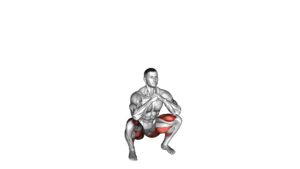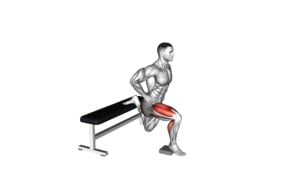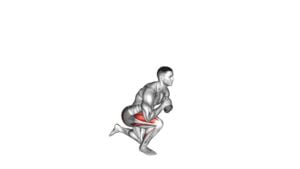Holding Squat (male) – Video Exercise Guide & Tips

Looking to improve your squat game? Check out this video exercise guide and tips specifically designed for males.
Watch This Exercise Video
In this article, you'll learn the benefits of holding squat, proper form and technique, common mistakes to avoid, and essential tips to enhance your performance.
Discover variations and progressions to challenge yourself even more.
Don't miss out on this comprehensive guide to mastering the holding squat.
Let's dive in and take your workout to the next level!
Key Takeaways
- Holding squat targets leg muscles including quadriceps, hamstrings, and glutes.
- Proper form and technique are important for holding squat, including keeping feet shoulder-width apart with toes slightly turned out and maintaining a tight core and straight back.
- Common mistakes to avoid in holding squat include rounding the back, overextending the knees, neglecting warm-up exercises, and not maintaining proper form.
- Proper form is important for avoiding injury, protecting the joints, and modifying the exercise for beginners or those with knee issues.
Benefits of Holding Squat for Males
You can experience numerous benefits by incorporating the holding squat into your workout routine as a male. Not only does this exercise work your lower body muscles, but it also helps improve your overall strength and flexibility.
One of the benefits of the holding squat is that it targets the muscles in your legs, including your quadriceps, hamstrings, and glutes. By regularly performing this exercise, you can develop stronger and more defined leg muscles.
Additionally, the holding squat can help increase your squat depth. To achieve this, focus on maintaining proper form and gradually increasing the weight or resistance used during the exercise.
Another benefit of the holding squat is its ability to improve your core strength. As you hold the squat position, your core muscles are engaged to maintain stability. This not only helps strengthen your abs and lower back muscles but also improves your balance and posture.
Incorporating the holding squat into your workout routine can provide you with a multitude of benefits, including improved leg strength, increased squat depth, and enhanced core stability.
Proper Form and Technique for Holding Squat
To ensure proper form and technique for the holding squat, focus on maintaining stability and engaging your core muscles throughout the exercise. This won't only help you improve your balance but also increase your lower body strength.
When performing the holding squat, start by standing with your feet shoulder-width apart and your toes slightly turned out. Keep your chest up and your shoulders back. As you lower your body into the squat position, make sure your knees track over your toes and your weight is evenly distributed through your heels. Aim to lower your hips until they're parallel to the ground, or as low as you can comfortably go.
Remember to keep your core tight and your back straight throughout the movement. To maintain stability, avoid rounding your back or letting your knees collapse inward. As you hold the squat position, focus on breathing deeply and maintaining proper alignment.
Common Mistakes to Avoid in Holding Squat
To ensure proper form and avoid common mistakes in holding a squat, it's important to pay attention to a few key points.
First, focus on maintaining proper form throughout the exercise, keeping your back straight and chest up.
Additionally, be mindful of avoiding knee overextension by not letting your knees go beyond your toes.
Proper Form Importance
Maintaining proper form in the holding squat is crucial for avoiding common mistakes. By focusing on your form, you can maximize the benefits of squatting for your overall fitness. Here are some key points to keep in mind:
- Importance of warm-up exercises:
- Warming up before attempting the holding squat helps to increase blood flow, loosen up your muscles, and reduce the risk of injury.
- Dynamic stretches like leg swings and bodyweight squats can prepare your body for the demands of the exercise.
- A warm-up routine also helps to improve your range of motion and flexibility, allowing you to perform the holding squat with better technique.
Avoiding Knee Overextension
Avoid overextending your knees to prevent injury and maintain proper form in the holding squat. Overextending your knees can put excessive strain on the joint and increase the risk of knee injuries. To avoid this, make sure to keep your knees in line with your toes throughout the exercise. Avoid locking your knees at the top of the movement and maintain a slight bend in them. This will help to protect your knees and ensure proper alignment.
Additionally, if you're a beginner or have knee issues, you can modify the holding squat by reducing the depth of the squat or using a stability ball against a wall for support. By following these tips, you can prevent knee injuries and perform the holding squat safely.
Now, let's move on to essential tips to improve your holding squat performance.
Essential Tips to Improve Holding Squat Performance
To improve your holding squat performance, it's essential to focus on proper form techniques, increasing flexibility, and building strength.
Maintaining proper form, such as keeping your feet shoulder-width apart and your knees aligned with your toes, will help you engage the correct muscles and prevent injury.
Additionally, incorporating exercises that target your lower body, such as lunges and squats, can help improve your overall strength and stability, allowing you to hold the squat position for longer periods of time.
Proper Form Techniques
Improve your holding squat performance with essential tips for proper form techniques. To maximize your results and avoid common mistakes, follow these tips:
- Keep your feet shoulder-width apart and toes pointed slightly outward.
- Engage your core and keep your chest up throughout the exercise.
- Lower your body by bending at the hips and knees, ensuring your knees don't extend past your toes.
Proper form is crucial for improving performance and preventing injuries. By maintaining a stable and balanced position, you'll activate the correct muscles and optimize the effectiveness of the exercise.
Remember to start with lighter weights and gradually increase the load as your strength improves. Focus on maintaining control and stability throughout the movement to get the most out of your holding squats.
Increasing Flexibility and Strength
To enhance your holding squat performance, focus on increasing flexibility and strength through targeted exercises.
Improving mobility is crucial for achieving a deeper squat position. Incorporate dynamic stretches such as leg swings and hip circles to warm up your muscles and increase range of motion.
Additionally, static stretches like the butterfly stretch and deep squat hold can help lengthen and relax tight muscles.
Building lower body strength is equally important for a strong holding squat. Include exercises like squats, lunges, and deadlifts to target your glutes, quads, hamstrings, and calves.
Gradually increase the weight and intensity of these exercises to challenge your muscles and improve their endurance. Remember to maintain proper form and listen to your body to prevent any injuries.
Variations and Progressions of Holding Squat
Explore different ways to advance your Holding Squat exercise by incorporating variations and progressions. Take your workout to the next level with these exciting options:
- Weighted Holding Squat: Hold a dumbbell or kettlebell in front of your chest while performing the squat. This variation adds resistance, challenging your muscles even more.
- Elevated Holding Squat: Place your heels on a raised surface such as a weight plate or step, with your toes on the ground. This modification increases the range of motion and targets your glutes and hamstrings.
- Pulse Squat: Instead of holding the squat position, perform small pulsing movements at the bottom of the squat. This variation intensifies the burn in your thighs and engages your muscles differently.
By incorporating these variations and progressions into your Holding Squat exercise, you can continue to challenge yourself and see steady improvements in your strength and endurance.
Now, let's move on to a sample holding squat workout routine that combines these variations for a well-rounded lower body workout.
Sample Holding Squat Workout Routine
Get ready to amp up your lower body workout with this sample Holding Squat workout routine. By incorporating the Holding Squat into your training regimen, you can increase endurance and maximize results for your lower body. This workout routine is designed to challenge your muscles, improve stability, and boost overall strength.
Begin your workout with a dynamic warm-up to prepare your body for the exercises ahead. Perform exercises such as leg swings, hip circles, and bodyweight squats to activate your muscles and increase blood flow.
Next, move on to the Holding Squat exercise. Start by standing with your feet shoulder-width apart and toes slightly turned out. Lower yourself down into a squat position, keeping your chest up and your knees in line with your toes. Hold this position for as long as you can, aiming to increase the duration with each workout. Challenge yourself by adding weights or performing squat pulses during the hold.
To maximize your results, incorporate variations of the Holding Squat into your routine. Try single-leg squats, squat jumps, or squat holds on an unstable surface like a BOSU ball.
Finish your workout with a cooldown that includes stretching exercises for your lower body muscles. This will help prevent muscle soreness and promote flexibility.
Remember to listen to your body and progress at your own pace. With consistency and dedication, this sample Holding Squat workout routine will help you achieve your fitness goals and take your lower body training to the next level.
Frequently Asked Questions
What Is the Recommended Duration for Holding the Squat Position?
To improve flexibility, the recommended duration for holding the squat position varies. However, it's generally suggested to hold the squat for at least 30 seconds to 1 minute.
This allows your muscles to stretch and adapt to the position, promoting increased range of motion. Remember to maintain proper form and listen to your body's limits.
Gradually increase the duration as you become more comfortable and flexible.
Can Holding the Squat Position Help Improve Flexibility?
Holding the squat position has several benefits.
One of which is improving flexibility. By maintaining the squat position, you engage and stretch various muscles, including the hip flexors, glutes, and hamstrings. This can lead to increased range of motion and improved flexibility over time.
Additionally, incorporating different squat variations into your routine can further enhance flexibility. By targeting different muscle groups and challenging your body in new ways, you can continue to improve your overall flexibility.
Is It Necessary to Warm up Before Performing the Holding Squat Exercise?
Before performing the holding squat exercise, warming up is essential. Incorporating holding squats into your warm up routine can provide several benefits.
It helps increase blood flow to your muscles, improves range of motion, and reduces the risk of injury.
However, it's important to avoid common mistakes while performing the holding squat exercise, such as rounding your back or letting your knees cave in.
Proper form and technique are crucial for getting the most out of this exercise.
How Often Should I Include Holding Squats in My Workout Routine?
To maximize the benefits of holding squats, it's important to include them in your workout routine regularly. The recommended frequency depends on your fitness level and goals, but incorporating them two to three times a week is a good starting point.
Holding squats help build lower body strength, improve stability, and increase flexibility. They also engage multiple muscle groups, including your glutes, quads, and core.
Are There Any Specific Breathing Techniques to Follow While Holding the Squat Position?
When holding the squat position, it's important to focus on your breathing technique. By taking deep breaths in through your nose and exhaling slowly through your mouth, you can maximize the benefits of this exercise.
Proper breathing helps to oxygenate your muscles and maintain stability during the hold. It also promotes relaxation and reduces tension in your body.
Conclusion
In conclusion, holding squats can be a beneficial exercise for males, helping to improve lower body strength and stability. By maintaining proper form and technique, avoiding common mistakes, and following essential tips, individuals can enhance their holding squat performance.
Additionally, incorporating variations and progressions into a workout routine can add variety and challenge. Remember to consult with a fitness professional before starting any new exercise program.

Author
Years ago, the spark of my life’s passion ignited in my mind the moment I stepped into the local gym for the first time. The inaugural bead of perspiration, the initial endeavor, the very first surge of endorphins, and a sense of pride that washed over me post-workout marked the beginning of my deep-seated interest in strength sports, fitness, and sports nutrition. This very curiosity blossomed rapidly into a profound fascination, propelling me to earn a Master’s degree in Physical Education from the Academy of Physical Education in Krakow, followed by a Sports Manager diploma from the Jagiellonian University. My journey of growth led me to gain more specialized qualifications, such as being a certified personal trainer with a focus on sports dietetics, a lifeguard, and an instructor for wellness and corrective gymnastics. Theoretical knowledge paired seamlessly with practical experience, reinforcing my belief that the transformation of individuals under my guidance was also a reflection of my personal growth. This belief holds true even today. Each day, I strive to push the boundaries and explore new realms. These realms gently elevate me to greater heights. The unique combination of passion for my field and the continuous quest for growth fuels my drive to break new ground.



